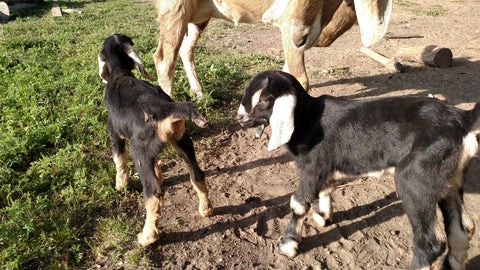Right now, I have three kids who are on their moms since they were born during the county fair. Later when the ground dries out from the torrential rains we just had in Houston, I will make them bottle-babies so we can use the milk because my pregnant does are slowing down in milk production.
I love to welcome them into our world, and when the kids get a little older, I enjoy watching them romp with our dog or with my grandchildren. However, after six weeks of hard work around-the-clock, I’ll introduce our little boy babies to their new families and forever homes. While they’re sweet and cute and cuddly, they require a lot of work.
The girls will provide me with lots of fresh milk for the goat cheese which I make for family and friends. That very same milk is in all of my handmade goatmilk soap, lotion, body butter, and liniment. I am very watchful over what my goats eat for this reason alone. I want to know exactly what’s in our food and what goes into my products. I know this is important to you, too.

Always get two so they are a small herd, or people need to be around all the time to be their herd and interact with them if there is only one. Provide lots of attention, shelter, and bottle for at least three months. For my babies that are staying, I feed bottles for close to five or six months. My boy babies will head to their new homes while still on bottles.
It’s so rewarding to watch them run toward me, like they love me, when in reality all they want is the bottle, but it’s still fun. Feeding bottles is how they become people goats. They’ll learn to trust and love their people by learning where their food comes from and they learn their names because we spend so much time with them.
We start them out at four to five bottles per day, or as much as they want for the first two weeks, then cut back to three bottles per day. When they turn two months old, I cut back to two bottles/day. No kid ever gets more than 64 oz per day. That is not necessary. I work them up to that much and hold them there until weaning.
Offer bottles and patiently wait. Sometimes, you may have to wait for days until the kid gets the hang of it. And don’t forget that every bottle baby is different and it takes us lots of time to get to know what they like and how they will thrive best. Some kids eat standing facing me, others stand between my legs facing forward, some prefer to be flopped over my lap with legs hanging, and others will not drink one sip until they are nestled completely in my lap with head tilted “just so”.
It can be very challenging to feed a bottle baby. So much so, that some people refuse to keep trying. Personally, I love the bottle-baby challenge. It is so rewarding to see that little tail wag with joy. It makes me giggle inside!

The Goat Care Unit Facebook Page
While I refer to these sites often, most of what I now know came from personal conversations with other goat owners, like Tanesha Hunter, of Hunter Goats. And, of course lots and lots of experience.
Contact me if you have a specific question. I’d be happy to help – as soon as I finish feeding my little ones. 🙂

Get Free Shipping On Orders Over $50